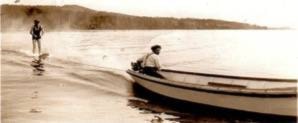© 2018 Michael Riis-Christianson and the Lakes District Museum Society
Many of this area’s earliest residents were loners, men whose independent nature made them perfectly suited for life in a land where four-legged inhabitants greatly outnumbered two-legged ones.
Tommy McKinley was one such individual. An Englishman and sailor, he showed up in the Ootsa Lake country in 1910 and built a cabin in the Streatham area. A trapper, perhaps by trade but likely by necessity, he spent his winters running lines in the wilderness surrounding Eutsuk Lake. In spring, he would return home for the ‘social season’, which often included a visit to the annual Trapper’s Rendezvous in the thriving metropolis of Burns Lake.
McKinley was well-liked by his neighbours. A handsome man with bright blue eyes and a blond handlebar moustache, he took pride in dressing well when not on the trail. His favourite outfit included a large cowboy hat and a brilliant white neckerchief – perhaps the only truly white one in the country. He reportedly had a beautiful singing voice, and enjoyed regaling local children with tales of his days as a sailor.
McKinley loved serial radio programs and followed them avidly.
Once, fellow pioneer Billy McNeill – intent on showing off some prime marten habitat – paid McKinley a visit. The two men set off together, but long before they reached their destination, McKinley became restless and said he had to return home. McNeill was astounded; at the time, a prime marten pelt was selling for the unheard of price of $100, and it wasn’t like McKinley to show such little interest in what was clearly an excellent business opportunity.
“You need to go home, Tom? What on earth for?” McNeill asked.
“Why, Bill,” replied McKinley, who often inserted the ‘H’ sound before his vowels, “Tarzan hof the Hapes his hon the radio tonight.”
With that, he turned and set out in haste for his cabin.
Like so many of his neighbours, McKinley was a confirmed bachelor. In his late 50s or 60s, he allegedly tried matrimony on for size, but apparently found the garment a poor fit. He described his marriage to Ms. McKinley (nee Middleton) as “six months of heaven and six months of hell,” which according to those who knew him well was approximately the amount of time he devoted to the exercise.
Though he never remarried, McKinley settled down somewhat in his later years. He moved to Ootsa Lake, built himself a house on floats, and went into the guiding business with McNeill. He and his partner took tourists fishing in the summer, but each fall, the siren’s song of Big Eutsuk lured him back to the trap line.
McKinley was one of more than 40 of this area’s settlers who attended the first “Old Timer’s Reunion” held in Burns Lake in 1944. We don’t know the year of his death, but there is a “Thos McKinely” buried in plot 1.1.A in the Burns Lake Cemetery. Could it be the final resting place of this adventurous sailor turned trapper?
